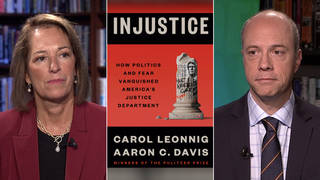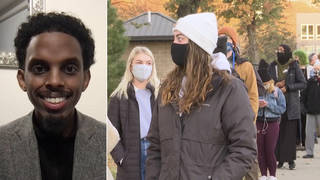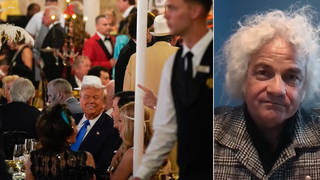
Guests
- Monica Younattorney in the Democracy Program of the Brennan Center for Justice.
- Juan GonzálezDemocracy Now! co-host and NY Daily News columnist.
An exhaustive review of all 1,994 constitutional cases decided by the Second Circuit during the decade of Judge Sotomayor’s service found that Sotomayor is solidly in the mainstream of her colleagues. The Brennan Center for Justice report found Sotomayor voted with the majority of the court in 98.2 percent of constitutional cases. We speak with the report’s author, attorney Monica Youn, and Democracy Now!'s Juan Gonzalez, who's in DC covering the hearings. [includes rush transcript]
Transcript
AMY GOODMAN: While many Republican critics of Sonia Sotomayor have attempted to paint the judge as a judicial activist, New York Senator Chuck Schumer and other Democrats have argued Sotomayor’s record clearly shows she’s a mainstream judge.
SEN. CHUCK SCHUMER: As we’ll hear in the next few days, Judge Sotomayor puts rule of law above everything else. Given her extensive and even-handed record, I’m not sure how any member of this panel can sit here today and seriously suggest that she comes to the bench with a personal agenda. Unlike Justice Alito, you don’t come to the bench with a record number of dissents. Instead, her record shows that she is in the mainstream.
She’s agreed with Republican colleagues 95 percent of the time. She has ruled for the government in 83 percent of immigration cases against the immigration plaintiff. She has ruled for the government in 92 percent of criminal cases. She has denied race claims in 83 percent of the cases and has split evenly on employment cases between employer and employee.
AMY GOODMAN: New York Senator Chuck Schumer.
We turn now to look at the actual judicial record of Judge Sonia Sotomayor. The Brennan Center for Justice has just completed an exhaustive review of every constitutional case decided by the Second Circuit during the decade of Judge Sotomayor’s service, a total of 1,194 cases in all.
The report found that the judge is solidly in the mainstream of the Second Circuit. The report found she voted with the majority of the court in 98.2 percent of constitutional cases. When she has voted to overrule a lower court or agency, her decisions have been unanimous over 93 percent of the time.
Monica Youn joins us now in our firehouse studio, attorney at the Brennan Center for Justice and author of the Center’s new report on Judge Sotomayor’s record.
Welcome to Democracy Now!
MONICA YOUN: Thanks so much for having me.
AMY GOODMAN: So, give us the overview. This is an unusual investigation that you’ve done.
MONICA YOUN: Sure. We wanted to test out some questions of whether or not Judge Sotomayor is indeed out of the mainstream or an outlier, as some critics have claimed. But I don’t really understand how you understand what out of the mainstream is before taking a look at what the mainstream is in the first place. So, what we wanted to do was to do a comparative analysis, not just of her record, but of how she looks against the background of judges who have looked at the same caseload, who have, you know, been sitting at the same period of time as Judge Sotomayor on the Second Circuit.
And to give you a little bit of context, the Second Circuit is a circuit that is known for being very collegial and for really prizing consensus. And we see Judge Sotomayor as very much coming out of that pattern. You mentioned already that 98 percent of her cases she was in the majority. But, you know, astonishingly, I think 94 percent of her decisions have been unanimous. And even when she has voted to, for example, overturn government action, we see those decisions getting bipartisan support. A Republican appointee has agreed with those decisions in almost 90 percent of cases.
AMY GOODMAN: And what are some of the cases that have stood out for you that you looked at and where she stood on them? Because it’s certainly not how she is being painted. And the difference between what it means to be a judicial activist and a mainstream judge?
MONICA YOUN: Sure. One of the decisions that stood out for me was her ruling in Pappas v. Giuliani, which is one of her rare dissents, I think one of just a handful of cases, you know, in the ones that we looked at that she actually did — was moved to write a dissent. And that was a case in which an employee of the police department, someone who had a desk job, had been receiving solicitations for contributions, and he sent out responses to those solicitations that were racist, that were offensive, and he was sending them out from his desk. And the question was, was the police department justified in firing this employee on the basis of those racist mailings that he sent out? I think that, you know, there was a question as to whether they were personal or whether they were as part of his public duty.
And the majority of the panel said that, yes, it’s OK to fire this person. And Judge Sotomayor dissented, and she said, “Yes, this speech is racist, it’s offensive. I hate this speech. But the First Amendment and thirty years of Second Circuit precedent have told me, have instructed me, that we cannot fire this employee on the basis of this racist speech. We, as the state, have to keep him — keep him as an employee. And I think that’s very much — she seems to be very much a rule of law sort of judge. And that’s, I think, a good example.
AMY GOODMAN: The firefighters’ case, explain it.
MONICA YOUN: Sure. The firefighters’ case is really quite a bit more complicated than it’s being painted. I mean, the way in which it’s being painted in some of these speeches is as if Judge Sotomayor somehow imposed some sort — a standard that takes race into account upon a city. In fact, what happened in that case is the city —-
AMY GOODMAN: This is New Haven.
MONICA YOUN: The city of New Haven commissioned a test. And this is a city -— you know, I went to law school in New Haven. This is a city that is rife with racial tension and one in which very much a priority of the fire department was to try to ensure to have, you know, fire department senior officers who, you know, look like the community, who would be able to speak for the community. So they commissioned a test, and they found that it disproportionately impact — disproportionately impacted, I guess, black and Latino firefighters and that those firefighters were not doing as well on that test as they should have.
Now, this test was, I think, in large part a multiple choice test, and there were a lot of questions in the record as to what sort of — you know, really what you want in a firefighter and someone who’s going to be commanding firefighters is someone who can respond under pressure, someone who can perform well in a crisis. And there was a real question as to how much cramming for a multiple choice test, in which I think the test materials themselves cost $500, is really worth.
So, anyways, some — the city sought to put aside the test results and to commission another test. And at that point, a group of firefighters sued, including the plaintiff, Ricci, and his co-plaintiffs.
And the Second Circuit precedent under the — under Title VII of the Civil Rights Act, I think, was pretty clear, as was the Supreme Court precedent. And the Second Circuit followed that precedent, and a unanimous panel said, OK, the city is — there is no constitutional — there is no violation of Title VII just because the city has put aside this test. It then went up, and the Supreme Court reversed. But when the Supreme Court reversed, they did so by putting forward a new principle of Title VII law. They changed the standard. The Second Circuit had been applying the old standards, as they had to.
AMY GOODMAN: And finally, what questions do you think aren’t being asked in these hearings?
MONICA YOUN: Questions that aren’t being asked are, I think, really more exploratory questions about what the nature of the judicial process is. Judge Sotomayor cited Justice Cardozo as her favorite justice. And Justic Cardozo famously wrote a book called The Nature of the Judicial Process, in which he engaged in a very introspective view of what judging is. What is it that I feel when I’m on the bench? What is this process that I’m engaging in?
And you can see Judge Sotomayor following this example in some of the speeches for which she’s taken so much flak. She’s been saying, “What are the preconceptions that I, with my particular background, have brought to the bench?” And you can see how that just has provided fodder for those who seek to attack her. They say, “Oh, even admitting that you have preconceptions is somehow bias.”
But how are you supposed to lay your preconceptions at the door, lay your biases at the door, before you step up to the bench, if you’re not even troubling to identify what your own preconceptions, what your own biases, might be? And, you know, I’d be fascinated to have some more realistic questions about what the nature of judging is asked of her and other nominees.
AMY GOODMAN: Monica Youn, attorney in the Democracy Program at the Brennan Center for Justice, responsible for the report on the record of Judge Sonia Sotomayor.
As we turn now to Democracy Now!’s Juan Gonzalez, who’s joining us from Washington, DC, in the Hart Office Building in the Senate hearing room where the confirmation hearings for Judge Sotomayor are happening.
Hi, Juan. What’s happening now?
JUAN GONZALEZ: Well, everyone’s getting ready for the resumption of the questioning by the Senate, as not all the senators were able to get through their first round yesterday. There were a handful that still had to go. And then they’re going to go through a second round, a shorter round, of questioning, once again. And so, it’s very doubtful that any of the other parts of the hearing, which will include witnesses called by both the Democrats and the Republicans, will begin today. There’s a possibility late in the day, but largely it will be the senators of the Judiciary Committee once again going — questioning Judge Sotomayor.
AMY GOODMAN: And Juan, what most struck you in the second day of hearings? You’ve attended both days.
JUAN GONZALEZ: Well, I think that the key — the key thing, as I mentioned in my column today in the Daily News, is how amazingly composed and cool Judge Sotomayor was through basically more than six hours of a grueling — it’s really a grueling process where you’re answering question after question. Now, there were a couple — there was a lunch break and a couple of short breaks, but basically you’re there answering repeated questions by a variety of senators, so that she was cool, showed an enormous grasp of Supreme Court precedent and obviously of her own decisions, but also of decisions that have occurred in other appeals courts that might inform how she made her decisions — her decisions. So, ultimately, she showed an enormous grasp of the law.
And at the same time, I think it was clear that she was basically involved in a prevent defense. The Obama administration feels confident that they have the votes to get her approved, so it was only a question of not making any major mistakes. And so, she was very cautious in a lot of her responses. And at one point, in fact, Lindsey Graham of South Carolina said, “We’re trying to figure out who are we getting here. I listen to you today, and I think I’m listening to Judge Roberts,” because she seemed to constantly refer back to — I guess her main theme is that she approaches her work as a judge with a fidelity to the facts, judging each case on its own merits. And when one of the other senators attempted to try to pin her down in terms of how she saw herself, either as a strict constructionist or as an originalist, she kept saying, “I don’t — I don’t use labels. I do not categorize myself that way.” And she basically — her main theme was “I follow the law. I follow the law as Congress has expressed it, as the Constitution dictates it, and then examine each case on its own merits.”
AMY GOODMAN: Juan Gonzalez, reporting from the Hart hearing room, where the confirmation of Judge Sonia Sotomayor is taking place. If she is confirmed to the Supreme Court, she will be the first Latina justice.












Media Options